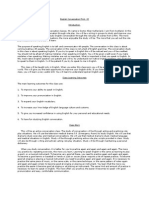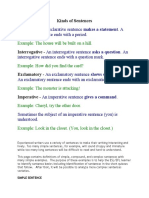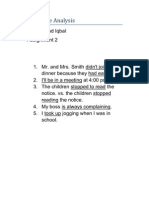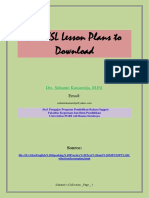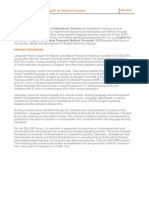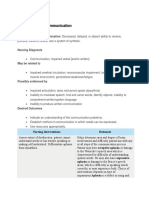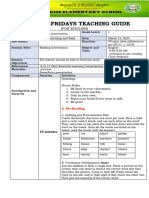Unit Ten-Teaching The Conversation Class
Unit Ten-Teaching The Conversation Class
Uploaded by
UnsaniaCopyright:
Available Formats
Unit Ten-Teaching The Conversation Class
Unit Ten-Teaching The Conversation Class
Uploaded by
UnsaniaOriginal Description:
Original Title
Copyright
Available Formats
Share this document
Did you find this document useful?
Is this content inappropriate?
Copyright:
Available Formats
Unit Ten-Teaching The Conversation Class
Unit Ten-Teaching The Conversation Class
Uploaded by
UnsaniaCopyright:
Available Formats
UNI T TEN: TEACHI NG THE CONVERSATI ON
CLASS
Teaching English as a Second
Language
Task
You are a student in a foreign language class. The
teacher comes in and says Today were going to
discuss oil pollution. How do you feel as a student?
Why might you not feel like taking part in this
discussion?
GOALS
Conversing in a Second
Language
Transactional Interactional
Focus of the
conversation is
primarily on the
meaning of the
message
Focus is on
maintaining social
relationsgreeting,
complimenting, and
chatting
Maintaining Interaction & Meaning
Activities include Examples
Ranking activities
Values clarification
Brainstorming
Simulations & role
plays
Group exchanges
Group Exchange
Students prepare a short list of controversial
statements for others to think about. Groups
exchange statements and discuss them.
Role-play
1. Preparing: review vocabulary, real world
knowledge related to the context and
content of the role play (eg returning a
broken item to a store)
2. Modeling and eliciting: demonstrate the
stages that are typically involved in the
transaction, eliciting suggestions for how
each stage can be carried out, and teaching
the functional language needed for each
stage.
3. Practicing and review: students are
assigned roles and practice a role play
using cue cards or realia to provide
language and other support..
Talk as Transaction
Brainstorming Activity: Step One (Label the
picture)
Step Two: Brainstorm
Step Three: Create short
conversations
Positives
Negatives
A: What do you think about ______?
(going to a bar alone)
B: It can be dangerous
Its a good way to make friends.
A: Have you ever ____________?
B: Yes, but ________________?
--------------------------------------------
Model the conversation.
Extend if necessary.
Let students practice with different
partners.
Brainstorming continued
Group Exchanges/Discussions
http://www.dailyesl.com/campground.htm
Work best if done in
conjunction with another
type of activity:
vocabulary, listening,
grammar, etc.
Beginning by introducing
the topic, perhaps
through a listening
Make sure students
understand vocabulary
and/or specific
grammatical structures
Open classroom
discussion
One on one discussions
Websites
http://www.eslflow.com/
http://iteslj.org/games/
Http://www.eslgold.com/speaking/tasks_main.html
http://www.dailyesl.com/
http://www.tefl.net/esl-lesson-plans/index.htm
Talk as Interaction
Difficult to teach
Unspoken rules
Culturally bound
(i.e. the way we give a
compliment, a greeting,
apology is different
between cultures)
best taught by providing
examples embedded in
naturalistic dialogs that
can serve to model
features such as opening
and closing
conversations, making
small talk, recounting
personal incidents and
experiences, and reacting
to what others say.
Talk as Interaction: Examples
reacting to what others say
students can be given a dialog
in which listener reactions
such as really, is that
right, wow, thats
interesting have been
omitted. Students work in
pairs to add them to the
dialog, practice the dialog
with the reactions, then
practice a different dialog,
this time adding their own
reactions.
A: I got a new car yesterday.
B: Really! What color is it?
A: Its red and its fast.
B: Wow! How much did it
cost?
A: $9,000.
B. Is that right? Thats cheap.
New cars usually cost a lot
more than that.
Talk as Interaction: Examples
conversation starters and personal recounts
Students have to respond by asking one or two follow
up questions.
For example:
I didnt sleep very well last night.
Look what I bought on Sunday. How do you like it?
Did that thunderstorm last night wake you?
Difficulties in Teaching Talk as Interaction
Culturally specific topics
require different types of
responses
What do you say in each of
the following situation:
1. A friend just had a new
baby
2. A friend passed a
difficult exam
3. Its your mothers
birthday
4. Wishing someone good
luck before something
difficult
5. A toast
What to Say When:
Assorted Social Phrases
Match social phrases and situations by placing the situation letters in the blanks beside the social
phrases.
Social Phrases Situations
1. How are you? How are you a. It is afternoon. You will see your friend in the
doing? How are things going?_G_ evening.
2. So long._______ b. Your friend doesnt see a car coming.
3. Good luck._____ c. Your friend looks sick. You are worried.
4. Same to you._____ d. Your friend got a poor grade on the math test.
5. You, too. _____ e. Words said to a customer by a salesperson.
6. May I help you?____ f. Your friend is taking a vacation.
7. Congratulations! ______ g. You meet a friend in the hall.
8. See you later._____ h. Your friend has been waiting for you for 20 min.
9. Pleasant dreams._____ i. Your mom is leaving for work in the morning.
10.Tough luck! ____ j. You accidently push someone on the bus.
11.Please forgive me._____ k. You are saying goodbye.
12.Excuse me. I beg your pardon.___ l. Someone says, Happy holidays.
13.Have fun. Have a good time.___ m. Your friend has a job interview.
14.Watch out!_____ n. You are being introduced to someone.
15.How do you do? Nice to meet o. Your friend has been admitted to a good college.
you.____ p. Someone says, Have a good weekend.
16. May I use your telephone?___ q. Your mom is going to sleep.
17.Im sorry Im late._____ r. You said something unkind to your friend.
18.Have a good day.____ s. You are in a friends home. You need to call home.
19.Have a good trip.____ t. Your friend is going to a dance.
20. Are you okay?_____
Characteristics of Language Fluency
1. The ability to handle unpredictable language
2. The ability to anticipate the direction a conversation
will take.
3. The ability to make oneself understood and negotiate
meaning (e.g. ask for clarification, paraphrase what
was understood); use compensation strategies (point
to something when you dont know the word for it,
describe an object for which you dont know the
name)
4. The ability to convey meaning and get things done
with the language, even with limited vocabulary or
accuracy.
5. The ability to pick up on and use visual cues from the
environment and other speakers/listeners.
Using Conversational Grammar
Based upon how people
talk
Features small chunks,
clauses, and single words
Influenced by the fact that
native speakers constantly
make mistakes when they
speak. They hesitate and
say the same thing in
different ways and they
often change the subject of
what they are saying in mid
sentence.
Example:
Jack: Hi, whats up?
Jane: Not much.
Jack: Headed to the
bookstore?
Jane: Yeah. Gotta buy art
supplies.
Jack: Oh, good! Glad I ran
into ya. Whatcha
halfta buy?
Jane: Colored chalk, ah..
sketch pad
hmmcharcoal sticks.
Using Conversational Grammar in Activities
Hiya. Whats ur name?
Im ____.
Whats ur name and where
ya from?
Im______ and
Im from_____.
Whatcha doing?
Studying for a
test..hmmwanna grab a
bit to eat?
Ahhsure
Introducing, Developing & Changing Topics
Conversational
opening
Guess meaning from
context for the
situation
yes
No
Renegotiate
meaning
Move to the next
step in the
conversation: elicit
questions/change
topic, etc.
Topics of
Discussion
Understanding
appropriate levels of
conversation is based
upon context, culture,
and the level of
formality in the
language
It is also based upon
WHO we are talking to
Taking Turns
Cultural differences
Students need to
understand how to
respond in an
appropriate time-frame.
What to do?
1. Explain the 2-4 second
rule
2. Go around room asking
students questions
3. After youve asked the
question, hold up four
fingers (and count
down for each second
that passes)
Turn Taking: Maintaining Control
Cultural differences for
interrupting and turn
taking
General Strategies:
Speaker controls the
conversation
Can stop someone from
interrupting by avoiding eye
contact
Dont drop the volume of your
voice
If someone interrupts and you
havent finished, tell them using
phrases like Let me finish/May I
finish etc.
When someone wont stop
talking & youre not interested in
what theyre saying, avoid eye
contact, turn away or look at
something else
Do not use conversational fillers
Conversational Routines
Mr s Jones: Anne, woul d
you l i ke some
mor e chi cken?
Anne: Oh, no t hank s!
Del i c i ous! I
c ant eat
anot her bi t e.
Mr s. Jones: Wel l , t her es
pl ent y. Hel p
your sel f !
Mr s Li u: Anne, some
mor e?
Anne: Oh, no t hank
you!
Mr s. Li u: I i nsi st . Have
some mor e.
Have some
mor e.
Anne: (Si l ent )
Mr s. Li u: (Put s t he
chi cken on
Annes pl at e)
Adapting Style
Conversing also includes
the selection of
conversational style to
match the formality of
the situation
Got time?
vs.
Whats the time?
vs.
Do you have the time?
vs.
Would you know what
time it is?
vs.
Could I trouble you for the
time?
PRAGMATI CS I S THE STUDY OF HOW
THE TRANSMI SSI ON OF MEANI NG
DEPENDS UPON NOT ONLY
LI NGUI STI C KNOWLEDGE ( E. G.
GRAMMAR, VOCABULARY, ETC) , BUT
ALSO ON THE CONTEXT OF THE
UTTERANCE, KNOWLEDGE ABOUT
THE STATUS OF THOSE I NVOLVED,
THE I NFERRED I NTENT OF THE
SPEAKER, ETC.
Developing Pragmatic
Competency in Conversation
Understanding Structural Ambiguity
You have a green light.
You are driving and the
light has turned green.
You possess a light
that is green.
Youve been given
permission to do
something.
You possess an energy
efficient light bulb.
Your body has a green glow.
Pragmatic Competency in Conversations
A: Good morning, Auntie Elizabeth!
B: Good morning, John!
A: How are you?
B: Well, Im not too well. Ive been
struggling with backaches
recently and you know my salary
is quite low. We can hardly make
ends meet at the end of the month.
A: Oh, well I think this is all the
governments fault. The such and
such party would do a much better
job.
B: Hmm, maybe. Well, here is my
bus. I have to go. Bye.
A: Hello.
In English, How are you? is usually
considered a greeting, not a real
question. However, in Hungarian, the
phrase Hogy vagy? or Hogy van?
(depending upon whether the speaker
uses the informal or formal form)
may communicate genuine interest in
the other speakers well-being.
English phrases, such as greetings, are
used in other languages, but often take on
a different meaning. In Hungarian, for
instance, hello, in addition to being a
greeting, is a leave-taking. Therefore, while
it is perfectly acceptable in Hungarian to
convey goodbye by saying hello, a native
English speaker hearing hello is likely to be
astonished by such a leave-taking.
Adult English speakers do not ordinarily
address someone as Auntie or Uncle unless
there is a genuine familial relationship of
that sort. In Hungarian, however, a similar
form exists (nni for females and bcsi for
males), and children and young people
may use it to address older adults outside
of their family. Because English does not
distinguish between formal and informal
forms, politeness or informality has to be
expressed by other means.
Pragmatic Differences in Speech Acts
Apologe
tic
formula
I'm sorry, I
apologize, I'm
afraid
Assuming
Respons
ibility
I haven't read
your paper
yet.
Account
I had to prepare my
TESOL plenary.
Offer of
Repair
But I'll get it
done by
Wednesday.
Appeaser
Believe me, you're
not the only one.
Promise
of
forbear-
ance
I'll do better
after TESOL.
Intens-
ifier
I'm terribly
sorry, I really
tried to
squeeze it in.
CONTROL THE TYPE OF QUESTI ONS
LI MI T THE SCOPE OF THE CONVERSATI ON
How do ESL Teachers Teach
Conversation to Beginners
Questions
limit the
scope of the
conversation
Questions for Beginners
Yes-no Questions Is Saras sweater blue?
Do Nigerians like to play soccer?
Did you get up early?
Can you speak Thai?
Either-Or Questions Is Saras sweater blue or green?
Do Nigerians like to play or watch
soccer?
Did you get up early or late?
Which can you speak better, Thai
or English?
Identify Questions What color is Saras sweater?
Which sport do Nigerians like to
play most?
What time did you get up?
What languages can you speak?
Quasi-communicative Activities
for students to
practice using English
with reasonable fluency,
but without having to be
overly concerned with
communicating meaning
effectively.
Charts
Schedules
Dialogue practices
DI ALOGUE WRI TI NG
SKI TS
ROLE- PLAYS
I MPROVI SATI ONS
BUZZ GROUPS
GAMES
COMPUTER MEDI ATED COMMUNI CATI ONS
What Kinds of Activities Do ESL
Conversation Teachers Use With
Post-Beginners
Look at these examples of some of the
most common teaching techniques for
getting students to practice speaking in
class.
Role-plays
Role-plays: Ss are given a specific role and have to make a
conversation.
A:Youre a tourist in Lima downtown. You need to
find you way to the nearest ATM. Ask a pedestrian
for directions.
B: You live in Lima. Youre stopped by a tourist.
Give him/her directions
For more ideas visit:
http://www.eslpartyland.com/teachers
Drills
Drills: Ss imitate and repeat words, phrases
and even whole utterances.
(Teacher or recorder)
Excuse me, is there an
ATM near here?
(Chorus) Yes, theres one
behind the cathedral.
(S1) Yes, theres one behind the
cathedral.
(S2) Yes, theres one behind the
cathedral.
For more ideas visit:
http://www.songsforteaching.com/chantsraps.htm
Chants
Chants: Students sing rhythmically specific target forms.
Giving directions
(Prepositions, Commands, and Classroom Vocabulary)
Turn to the left and then to the right there youll find the place
you want
Go straight on
Dont cross the street
Theres a bank in the front
For more ideas visit:
http://www.songsforteaching.com/chantsraps.htm
Flow-diagram conversations
Flow-diagram conversations: Students perform the dialogue,
following the arrows.
A: Stop B
B: Listen A
B: Answer A
A: Ask for directions
B: Give directions
A: Thank B
For more ideas
visit:http://english.unitecnology.ac.nz/resources/units/titanic/flow.html
Picture and Word Cues
What happened?
For more ideas visit:
http://www.eslhq.com/forums/worksheets/esl-worksheets/
Disappearing Dialogue
Disappearing Dialogue: Students repeat the whole dialogue and then
teacher erases one sentence at a time.
Tourist: Excuse me
Pedestrian: Yes?
Tourist: Is there a movie theater near here?.
Pedestrian: Yes. Theres one on the corner of BloorStreet
West and Albany Avenue.
Tourist: Thanks a lot!
For more ideas
visit:http://esl.about.com/library/speaking/bldialogues_restaurant.htm
Teacher roles during a speaking lesson
Organizer: Get Ss engaged and set the activity.
Prompter: Provide Ss with chunks not words.
Observer: Analyze what causes communication breakdowns.
Participant: Do not monopolize or initiate the conversation.
Assessor: Record mental or written samples of language
produced by Ss.
Feedback provider:
Tell Ss how proficient their performance was.
Resource: Provide Ss with tools to improve their oral
performance.
PRONUNCI ATI ON I N YOUR CURRI CULUM
The Place of Pronunciation in
ESL Instruction
Factors Affecting Pronunciation
First language
How phonetically different are the 1
st
& 2
nd
language? Learners whose 1
st
language is more phonetically similar to English will not necessarily have the
most ease in acquiring the sounds of the new language.
Age
Generally speaking, learners exposed to English before puberty are more
likely to achieve a native-like accent in a 2
nd
language.
Motivation
Why do the learners want to study English? Motivation that derives from
negative reactions from family members or employers may be a cause for
frustration rather than a positive motivator.
Expectations
Along with motivation comes expectations about how one wants to sound in
a 2
nd
language. Few adults ever attain a native-like accent in a 2
nd
language,
but some hold this as a goal of instruction.
Exposure to
English
How often is the student exposed to English in the current environment?
The more exposure a student has to the language, the better their chances
are at increasing their pronunciation skills.
Attitude &
Identity
Accent has a strong impact on our identity, as 1
st
language speakers or 2
nd
.
Learners may have a strong desire to sound like peers rather than a native
speaker; this can result in a resistance to work on English pronunciation.
Innate phonetic
ability
Some learners may be better than others at discriminating sounds or
mimicking sounds.
Production Performance
Able to understand
discrete sounds, stress,
intonation, rhythm
patterns
Refers to overall
intelligibility (the
ability to make oneself
understood)
Communicability (the
ability to meet
communicative
demands)
Pronunciation
Two Areas of Pronunciation
The phonemes of
the languages
(smallest units)
/b/ /v/
Segmentals
stress
Rhythm
Intonation patters
Suprasegementals
Common Segmental Difficulties
if the two sounds are not phonemic in the learners 1
st
language , they may have difficulty in differentiating
between the two sounds in English.
Deletion and insertion of sounds
-consonant clusters may not exist in the L1
-Japanese speakers commonly insert a vowel
between consonants
-final -s omissions
Common Suprasegemental Difficulties
I have lice with all my
meals
or
This shirt feets me well
Now you need to add cold
cream.
What would happen to the
meaning of the sentence if
you said cold cream?
What did you think of the
comedy?
or
What did you think of the
committee?
Shes my sister, Marcia. (Marcia
is your sister.
Shes my sister, Marcia.
(Youre identifying your sister
for someone else named
Marcia)
Approaches to Teaching Pronunciation
Description and
analysis
Listening
discrimination
Controlled practice
Guided practice
Communicative
practice
Description and analysis
The goal of these steps is to raise learners
awareness of segmental and
suprasegmental features through the use
of visual charts, drawings, hand
gestureswhatever means are within
your learners language abilities.
Listening Discrimination
Learners need to take part in these types
of activities to allow them to demonstrate
their ability to perceive sounds or
patterns of the language.
Controlled Practice
Once your learners begin to perceive
patterns, your instruction can turn to
activities that provide opportunity to say
the target sounds repeatedly, but in a
meaningful context.
Guided Practice
Finally, it is important that learners
practice pronunciation patterns in
unplanned, extended speech (much like
authentic use). The activities will not be
completely spontaneous because you will
guide the students to use particular
pronunciation patterns.
Self Improvement
Teaching Students Strategies for Self-
Improvement in Pronunciation
Strong, vigorous practice Use vigorous practice with strong muscular
movements. Use exaggerated mouth
movements, overly articulating words.
Self-monitored practice Listen closely to and monitor yourself on
both the sounds and the rate, rhythm and
vocal qualities. Pay attention to stress points,
pitch tones and rhythmic patterns.
Slow-motion practice: Half-speed practice Try slow motion practice for a strong sense
of kinesthetic touch-and-movement feedback
and for the feeling of articulation
Lope Practice Use an endless loop practice of 20 or more
strong and vigorous repetitions of a
word/phrase.
Whisper practice Use whispered or silent practice to focus on
articulation
Mirror practice, video practice Use mirrors to view the articulation of
specific sounds. IF possible, zoon in on a
close-up of your face as you articulate words.
The Importance of Speaking
Exercises
Why are Speaking Exercises Important in ESL?
Conversation exercises are meant to introduce a
specific communicative function (ordering food,
making a phone call, asking for prices, etc)
They present new grammar structures in a
situational and communicative context.
They introduce new vocabulary in context.
They make good pronunciation models.
How to teach students to speak in English
For an effective speaking lesson, teachers need to be
aware of, knowledgeable about, and familiarized
with the teaching stages of a speaking activity as well
as the teaching techniques used for fostering
speaking in class. Also, the teacher role is crucial to
the effectiveness of the activity.
Teaching Stages for a Speaking Activity
a)Pre-communicative stage
b) Practice Stage
c) Communicative interaction or production
stage
During the pre-communicative stage,
Introduce the communicative function
Highlight the fixed expressions
Point out the target structure
Provide Ss with the necessary vocabulary
Provide Ss with the language of interaction
During the practice stage,
Correct Ss if necessary
Prompt Ss if necessary (do it lexically)
Ban (monolingual) dictionaries
Aim for intelligibility
During the communicative interaction,
Encourage language negotiation
Take note of any aspects that may hinder
communication (pronunciation, vocabulary,
grammar)
Respect Ss waittime
Feedback
Give Ss feedback on their pronunciation, grammar,
vocabulary and ask Ss to repeat the task if necessary
Homework
Prepare a 30 minute conversation lesson for an
intermediate ESL class. Be sure to include aspects of
pronunciation and vocabulary.
References
1. Celce-Murcia, Marianne, D. Brinton, and J. Goodwin. (1996). Teaching
Pronunciation. New York: Cambridge University Press.
2. Gebhard, Jerry G. (2009). Teaching English as a Foreign/Second
Language. Ann Arbor, MI: The University of Michigan Press.
3. Edwards, Melinda and K. Csizer. Developing Pragmatic Competence in the
EFL Classroom. English Teaching Forum. Vol. 42:3.
4. Parrish, Betsy. (2004). Teaching Adult ESL. New York: McGraw-Hill.
5. Pragmatics. (http://en.wikipedia.org/wiki/Pragmatics). June 26, 2011.
You might also like
- Business Communication Polishing Your Professional PresenceDocument619 pagesBusiness Communication Polishing Your Professional PresenceDanny Devi Ananda100% (3)
- Grade 11 STEM Interdisciplinary Performance Task Set BDocument3 pagesGrade 11 STEM Interdisciplinary Performance Task Set BJENNICA GRACE E. YNCHAUSTINo ratings yet
- Lesson Plan Case 1Document4 pagesLesson Plan Case 1api-284984246No ratings yet
- TEFL Entrance ExamDocument3 pagesTEFL Entrance ExammerekNo ratings yet
- Testing: Reasons For Testing StudentsDocument6 pagesTesting: Reasons For Testing StudentsDobreanu SoranaNo ratings yet
- TSL 641 Sample Esl SyllabusDocument4 pagesTSL 641 Sample Esl Syllabusapi-228461205100% (1)
- Syllabus - Conversational EnglishDocument2 pagesSyllabus - Conversational EnglishLaura Martínez100% (1)
- Teaching PreLiterate AdultsDocument5 pagesTeaching PreLiterate AdultsHripsimeNo ratings yet
- Beginning ESL SyllabusDocument4 pagesBeginning ESL Syllabusrahhal ajbilouNo ratings yet
- Tips For TeachingDocument11 pagesTips For TeachingAna AlmeidaNo ratings yet
- Ellt Methods and ApproachesDocument53 pagesEllt Methods and ApproachesFabian TorresNo ratings yet
- Word Order 1Document30 pagesWord Order 1AgungNo ratings yet
- Example Rubrics Used at UODocument7 pagesExample Rubrics Used at UOsandrago75100% (1)
- Test Review: TOEFL, IELTS, ACT Compass ESL Test Kathleen Hamel Colorado State UniversityDocument16 pagesTest Review: TOEFL, IELTS, ACT Compass ESL Test Kathleen Hamel Colorado State UniversityKathleen HamelNo ratings yet
- Semester 1 Grade 7 SyllabusDocument3 pagesSemester 1 Grade 7 SyllabusDarryl Lee SalterNo ratings yet
- Esl Newsletter OctoberDocument2 pagesEsl Newsletter Octoberapi-232234414No ratings yet
- Lesson Plan 8 Supermarket ShopDocument10 pagesLesson Plan 8 Supermarket ShopJo GregoryNo ratings yet
- ESL Textbook RubricDocument2 pagesESL Textbook RubricRicardo Ribeiro100% (1)
- Assessing SpeakingDocument18 pagesAssessing SpeakingAisyah MusfirahNo ratings yet
- English Second Language Strategies For Advanced Learners in Grades 4-12Document66 pagesEnglish Second Language Strategies For Advanced Learners in Grades 4-12Goksu CavusogluNo ratings yet
- Preposition Lesson PlanDocument11 pagesPreposition Lesson Planapi-248341220100% (1)
- English Conversation PrintDocument4 pagesEnglish Conversation PrintNovisaranghae DonghaeNo ratings yet
- Kinds of Sentences Declarative - : Example: The House Will Be Built On A HillDocument4 pagesKinds of Sentences Declarative - : Example: The House Will Be Built On A HillKate Cris TalatagodNo ratings yet
- Intensive and Extensive ListeningDocument18 pagesIntensive and Extensive ListeningMaria Octa ElsavanaNo ratings yet
- Esl Literacy Lesson EmergenciesDocument17 pagesEsl Literacy Lesson Emergencieshuntclub75% (4)
- Language AnalysisDocument13 pagesLanguage AnalysisMuhammad Iqbal100% (4)
- TESOL Sample SyllabusDocument3 pagesTESOL Sample SyllabusAndrew Hirsh100% (2)
- Types of DictationDocument4 pagesTypes of DictationLuis Enrique Simancas HernandezNo ratings yet
- When Writing A Lesson Plan: To ConsiderDocument2 pagesWhen Writing A Lesson Plan: To ConsiderTarik MessaafNo ratings yet
- 3.1 Games in The ESL and EFL Class (TESL - TEFL)Document5 pages3.1 Games in The ESL and EFL Class (TESL - TEFL)chiewjungNo ratings yet
- Text 13 - Teaching Language SkillsDocument17 pagesText 13 - Teaching Language SkillsVerônica ReisNo ratings yet
- Electic Approach 2Document2 pagesElectic Approach 2iramshakoorNo ratings yet
- ESL SyllabusDocument2 pagesESL SyllabusphillipeNo ratings yet
- Linguistics 1Document29 pagesLinguistics 1Hakkuo AmeNo ratings yet
- Reflective Lesson Plan (Idioms)Document7 pagesReflective Lesson Plan (Idioms)rpaige14No ratings yet
- Best Practices ESLDocument10 pagesBest Practices ESLdjelifNo ratings yet
- Cultural and Religious Factors Affecting The Teaching and Learning of English in Suadi ArabiaDocument10 pagesCultural and Religious Factors Affecting The Teaching and Learning of English in Suadi ArabiasamiraNo ratings yet
- Psychology of LanguageDocument37 pagesPsychology of LanguagePascalNo ratings yet
- A Summary LANGUAGE ASSESSMENT: Principle and Classroom Practice H. Douglas Brown (2003)Document5 pagesA Summary LANGUAGE ASSESSMENT: Principle and Classroom Practice H. Douglas Brown (2003)fildzahNo ratings yet
- V6 TesolDocument192 pagesV6 TesolJuliansyaNo ratings yet
- Absolute Beginner English PDFDocument4 pagesAbsolute Beginner English PDFMadalina Gheorghiu0% (1)
- Esol ReflectionDocument3 pagesEsol Reflectionapi-327783382No ratings yet
- Approaches To Teaching WritingDocument1 pageApproaches To Teaching WritingHeniarti Sri Agusta100% (1)
- English-Lessons (Grade 1)Document5 pagesEnglish-Lessons (Grade 1)Richmark MacuhaNo ratings yet
- A Syllabus For Academic DiscourseDocument9 pagesA Syllabus For Academic DiscourseEl EmeNo ratings yet
- Toefl Ibt Preparation Course Summer 2010 SyllabusDocument2 pagesToefl Ibt Preparation Course Summer 2010 Syllabusapi-326289552100% (1)
- Free ESL Lesson Plans To DownloadDocument12 pagesFree ESL Lesson Plans To DownloadamirNo ratings yet
- Scanni Simona - Lesson PlanDocument15 pagesScanni Simona - Lesson PlanannaNo ratings yet
- PronunciationDocument2 pagesPronunciationLuis Carlos Ojeda García100% (1)
- IELTS Writing Task 2 "People Prefer To Rent A House For Accommodation ScribdDocument1 pageIELTS Writing Task 2 "People Prefer To Rent A House For Accommodation ScribdGurpal VehniwalNo ratings yet
- Reading B1 All DocumentsDocument12 pagesReading B1 All DocumentsupsiggerNo ratings yet
- A Model Activity Using The Teaching of Grammar Through DictoglossDocument7 pagesA Model Activity Using The Teaching of Grammar Through DictoglossNina Adzhar100% (1)
- Minimal PairsDocument12 pagesMinimal PairsJosué OrtegaNo ratings yet
- Diction and Elocution For EyfsDocument5 pagesDiction and Elocution For EyfsCelestina IheanachoNo ratings yet
- CF Sites Default Files Downloads Selecting Methods and MaterialsDocument35 pagesCF Sites Default Files Downloads Selecting Methods and MaterialschiewjungNo ratings yet
- Selecting An English Learning Program For Your StudentsDocument8 pagesSelecting An English Learning Program For Your Studentscorey_c_mitchell100% (1)
- 179 - English For Nurses & English For Medical PurposesDocument2 pages179 - English For Nurses & English For Medical PurposesrizkiNo ratings yet
- Teaching ListeningDocument17 pagesTeaching ListeningMasrur Abdullah100% (1)
- ESL Placement Test 1 2012Document2 pagesESL Placement Test 1 2012jikoljiNo ratings yet
- 2-in-1 Book Series: Teacher King’s English Beginner Course Book 1 & English Speaking Course Book 1 - Spanish EditionFrom Everand2-in-1 Book Series: Teacher King’s English Beginner Course Book 1 & English Speaking Course Book 1 - Spanish EditionNo ratings yet
- Preston Lee's Conversation English For Japanese Speakers Lesson 21: 40From EverandPreston Lee's Conversation English For Japanese Speakers Lesson 21: 40No ratings yet
- Tabel PeriodikDocument1 pageTabel PeriodikUnsaniaNo ratings yet
- Jurnal ElektroforesisDocument5 pagesJurnal ElektroforesisUnsaniaNo ratings yet
- As A Taxpayer: Your RightsDocument2 pagesAs A Taxpayer: Your RightsUnsaniaNo ratings yet
- Jurnal Uv Vis 8Document3 pagesJurnal Uv Vis 8UnsaniaNo ratings yet
- Translation Module 26 Semester 2Document30 pagesTranslation Module 26 Semester 2Kai KokoroNo ratings yet
- World Englishes Hardback With Audio CD Frontmatter PDFDocument8 pagesWorld Englishes Hardback With Audio CD Frontmatter PDFkikiyanNo ratings yet
- LC4 Social Lit.Document12 pagesLC4 Social Lit.Shaira LiabanNo ratings yet
- How To Use SaypYu For English SpeakersDocument5 pagesHow To Use SaypYu For English Speakersuncle.philNo ratings yet
- Why Children With Dyslexia Struggle With Writing and How To Help ThemDocument21 pagesWhy Children With Dyslexia Struggle With Writing and How To Help ThemLuis.fernando. GarciaNo ratings yet
- How Do You Spell Your Name/ It?Document2 pagesHow Do You Spell Your Name/ It?Sir CrocodileNo ratings yet
- School PaperDocument3 pagesSchool PaperALEXANDER ATANACIONo ratings yet
- CO 2024 LS G1 NRP English - Q1 W1Document52 pagesCO 2024 LS G1 NRP English - Q1 W1gundayaogenesisNo ratings yet
- Screencast RubricDocument2 pagesScreencast Rubricapi-272483612No ratings yet
- Y6 e L65 - L69 (U5)Document8 pagesY6 e L65 - L69 (U5)lizNo ratings yet
- Approaches T Teaching WritingDocument10 pagesApproaches T Teaching WritingWided SassiNo ratings yet
- TOP 20 PowerPoint Tips - PatreonDocument64 pagesTOP 20 PowerPoint Tips - PatreonNicolae SoanaNo ratings yet
- Book Slides - Chapter 11 - CommunicationDocument28 pagesBook Slides - Chapter 11 - CommunicationKiran KhemkaNo ratings yet
- Laadaldai DadadaDocument51 pagesLaadaldai DadadaEmma María Del Toro BlancoNo ratings yet
- 7.4 Klasa 7 Periudha e Trete Spark 2Document4 pages7.4 Klasa 7 Periudha e Trete Spark 2Gerta TonaNo ratings yet
- Unreal Past TeachingDocument13 pagesUnreal Past Teaching01vpetraNo ratings yet
- 21st Century Literature - Unit 1 - Lesson 3 - Literary Reading Through A Linguistic ContextDocument26 pages21st Century Literature - Unit 1 - Lesson 3 - Literary Reading Through A Linguistic ContextxianmaedoroinNo ratings yet
- Guidelines To Literary EssaysDocument58 pagesGuidelines To Literary EssaysThi Nguyễn Thị CẩmNo ratings yet
- Spanish Pronunciation - QuizizzDocument5 pagesSpanish Pronunciation - QuizizzSEBASTIÁN PABÓNNo ratings yet
- Types of TranslationDocument57 pagesTypes of Translationmltubio100% (3)
- ENG 100 MidtermDocument8 pagesENG 100 MidtermTwinky CasidsidNo ratings yet
- Lesson Plan - Little Red Riding HoodDocument3 pagesLesson Plan - Little Red Riding HoodydsatalayserhanNo ratings yet
- Impaired Verbal CommunicationDocument3 pagesImpaired Verbal CommunicationCalimlim KimNo ratings yet
- CCW332 - Digital Marketing - SyllabusDocument2 pagesCCW332 - Digital Marketing - SyllabusV ArunachalamNo ratings yet
- Grade7English2017 2018 - 1 4QDocument10 pagesGrade7English2017 2018 - 1 4QRoseann Hidalgo Zimara100% (2)
- English March 15, 2024Document5 pagesEnglish March 15, 2024Ma. Jhysavil ArcenaNo ratings yet
- Biber (2004) PDFDocument20 pagesBiber (2004) PDFaiemaanNo ratings yet
- ЗАВДАННЯ ДЛЯ ІНДИВІДУАЛЬНОЇ РОБОТИDocument6 pagesЗАВДАННЯ ДЛЯ ІНДИВІДУАЛЬНОЇ РОБОТИЄвгенія ПоповаNo ratings yet





















